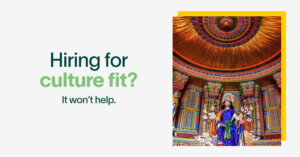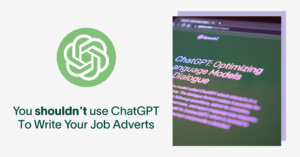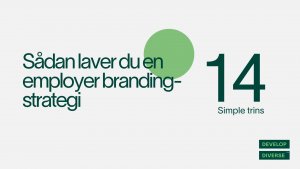Every second we spend on the internet, we’re being bombarded with images. You might not notice most of them as you’re scrolling through your Instagram feed, your online grocery shop, or even applying for a new role.
However, for people from marginalised groups, each image represents an opportunity to feel exclusion and discrimination. And when you’re trying to build a more inclusive, equitable company, this is the last thing you want.
But don’t worry — we’ve got you. In this post, Emil Novák-Tót, Head of Research at Develop Diverse, explains why your website image selection is so important for your employer and company branding, and suggests how you can make some simple, more inclusive and intentional fixes.
What your website images say about your company and employer branding
“Your choice of images on your website can say a lot of different things about you as a company,” Emil says. “It really depends on the context in which you place these images. Where and how are you using them? What’s their juxtaposition to the text on your website? These can change how they are perceived.”
Image position on the page, the image’s content, and the image’s relationship to any text on the page shape our understanding of what the image means. But this can be compounded by our own stereotypical expectations and unconscious biases about what — or more specifically — who we expect to see in the image.
“Often we use images in very stereotypical ways on websites — especially on recruitment websites,” Emil says. “Even on just a gender binary, you might have a web page linking to your customer service section, for example, that uses an image of a woman, for example. In male-dominated industries, it’s common to see images of men on the careers page.
“From a race or ethnicity perspective, organisations often run into problems, too. They might select team images, or stock images, that show people of colour. But usually, the people of colour are shown in the background — or they might take passive roles in the picture, which communicates a power dynamic, rather than actual inclusion.”
Things get trickier when organisations try to highlight they’re welcoming to all — especially if it’s not quite the truth yet. “You might be using images to highlight that your company is a welcoming place for people from all walks of life in a recruitment context. But if you’re using stock images on your careers page that display a greater level of diversity than what you actually have, that’s going to feel really misleading to candidates applying for roles.”
When your website images don’t match the reality of your organisation, says Emil, research has shown that there’s a cognitive dissonance between what people actually picture in their mind versus the reality. Ultimately, this harms trust in your company — whether it’s a candidate applying for a role or a customer.
5 key tips to make your website images more inclusive
Choosing the right images to represent your brand can be a minefield when it comes to diversity, equity, and inclusion.
Here are Emil’s five key tips to becoming more intentional about the images you choose for your website, and understanding meaning they convey:
- Think about what your images say: It’s totally fine to use stock images — but make sure when you search for stock images like ‘diverse teams’, that you’re fully analysing what the picture might represent for people from different groups. If your image is of a diverse group in a meeting, for example, look at how different groups are represented within the image. “Consider how your image might reinforce stereotypes, discriminatory social roles, or unconscious biases,” Emil says.
- Add alt text: Adding alt text for all images in your website provides a description of what the image is, or what purpose it serves on your webpage. This improves the accessibility of your website for people who are blind, have low vision, or who are neurodivergent.
- Consider your choice of illustrations: Inclusive imagery isn’t just about photos — any illustrations you use as part of your website, blog, or social media may also communicate unintended unconscious biases. Think about how concepts like race, disability, LGBTQIA+, and gender are represented in any illustrations you use. For example, if your reference point for disability is someone in a wheelchair, that could be a sign that your images are non-inclusive.
- Be intentional with team photos: Showcasing the inclusivity of your culture with team photos is an essential part of building a diverse and inclusive organisation. But make sure you’re not unintentionally being tokenistic. “If you keep asking marginalised employees to pose for photos, or using photos of marginalised employees for employer branding or to represent your diversity campaign, you need to think about how meaningfully they are actually included in your workplace,” Emil says.
- Think about the whole context: Your web page includes images and words. And the words around the image really matter. “You have to consider the context around the images — where they are, and what their function is in relation to the page,” Emil says.
Ultimately, says Emil, if you’re still not sure on how your images are received, then it’s best to bring in some help. But, he says, think carefully about who you ask to vet your image choices.
“Marginalised employees can very often bear an extra load of emotional labour when faced with asks like vetting your website images, or helping with your diversity and inclusion efforts,” he says. “If you have employee resource groups, they may be able to help here — but you can also work with consultants to help you do a sensitivity review without placing this labour on your marginalised employees.”
Communicate more inclusively with Develop Diverse
When it comes to inclusion, words matter — whether they’re in your job advert, your website, or your employer branding efforts. Communicating more inclusively goes hand-in-hand with the images you choose, and your efforts to create an organisation where everyone feels represented and welcomed.
Develop Diverse is an inclusive communication platform that helps organisations communicate more consciously in written text. Based on cutting-edge research, we work with global organisations to help them understand the impact of their language, and build better places to work. Find out more with a demo from our team.





